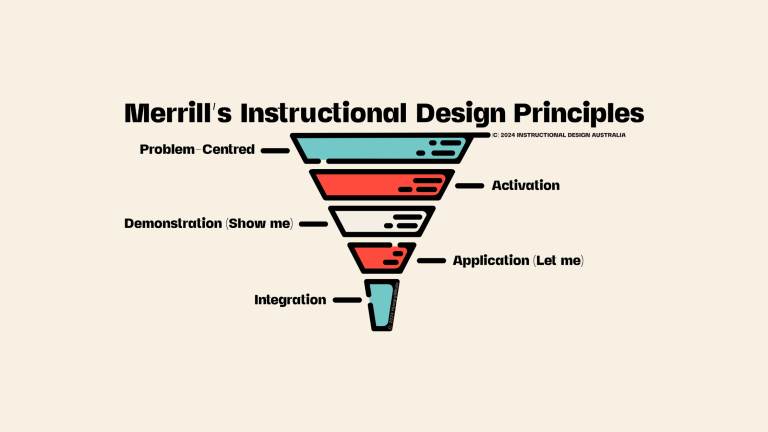AKA: Merrill’s Tips for Awesome Learning
Alright, let’s break down what the researchers have to say about making instruction really hit home. So, there’s a bunch of theories floating around out there, but how do we make sense of it all? Well, David Merrill, a big shot in education circles, went digging into instructional design theories and found some common ground. From his research, he came up with five key principles that can jazz up any learning program or practice to make it top-notch. They are called Merrill’s Instructional Design Principles.

 Problem-Centered Learning:
Problem-Centered Learning:
This one’s all about diving into real-world problems. Think of it like solving puzzles that actually matter. There are three stages to this approach: first, you show folks the task; then, you get them engaged at different levels of the problem; and finally, you crank up the complexity gradually, kind of like building with LEGO bricks.
 Activation:
Activation:
Ever heard of activating existing knowledge? It’s like priming the brain. Before throwing new stuff at learners, tap into what they already know. It’s about linking the old with the new, so it all makes sense.
 Demonstration (Show me):
Demonstration (Show me):
Show, don’t just tell. When introducing new ideas, give examples, demonstrations, and different perspectives. It helps learners connect the dots and apply what they’ve learned.
 Application (Let me):
Application (Let me):
Learning isn’t just about knowing stuff; it’s about doing stuff too. Give learners chances to practice what they’ve learned in different situations. Start with guidance, then let them spread their wings and fly solo.
 Integration:
Integration:
This is where the magic happens. New knowledge should blend seamlessly into learners’ lives. Let them show off what they’ve learned, reflect on their progress, and apply it in real-life situations. It’s all about making it personal.
So, next time you’re cooking up a learning program, keep Merrill’s principles in mind. They’re like the secret sauce for whipping up effective and efficient instruction that sticks.
FAQs - Frequently Asked Questions about Merrill's Instructional Design Principles
In a nutshell, Merrill’s principles highlight that learning is promoted when:
- Learning is problem-centred and learners are engaged in solving real-world.
- Existing knowledge is activated as a foundation for new knowledge.
- New knowledge is demonstrated to the learner.
- New knowledge is applied by the learner.
- New knowledge is integrated into the learner’s world.
When developing your next program, keep Merrill’s five instructional design principles top of mind to ensure your instruction is efficient and effective. Apply Merrill’s principles by:
Using problem-based learning to engage learners in real-world problems.
Activating existing knowledge before introducing new content to help them link and meld the ‘old’ with the ‘new’.
Incorporating multiple demonstrations of the concepts where possible to provide context and deepen learners’ understanding of its application.
Ensuring that opportunities are included for learners to apply their new insights and practice skills, such as scenarios and simulations.
Helping learners to integrate their new understanding and skills into their own lives through embedding activities to support learning transfer.
Merrill’s five principles of instructional design are:
Problem-centred
Activation
Demonstration
Application
Integration
Advantage: A clear and concise model for the creation of a learning solution.
Disadvantage: Design-focused only – it does not incorporate how to identify learning needs or to evaluate the program for improvement.
The goal of Merrill’s principles of instruction is to provide a framework for designing effective instruction to maximise learning.
References
Merrill, M. D. (2002). First principles of instructional design. Educ. Technol., Res. Dev. 50: 43–59.
Bayat, S. (2012). Effects of problem-based learning approach on cognitive variables of university students. Elsevier.
Mossuto, M., (2009). Problem-based learning: Student engagement, learning and contextualised problem-solving.
Radford University (n.d.). Problem Solving, Critical Thinking, and Analytical Reasoning Skills Sought by Employers. Retrieved from https://www.radford.edu/content/cobe/innovation-analytics/analytics/career-prep/report-e.html
Mayer, R.E. (2001). Multimedia learning. London: Cambridge University Press.
Merrill, M.D., Tennyson, R.D. & Posey, L.O. (1992). Teaching concepts: An instructional design guide (2nd Ed.). Englewood Cliffs, NJ: Educational Technology Publications.


